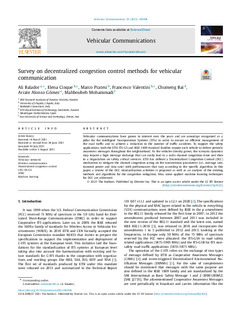| dc.rights.license | Attribution 4.0 International | * |
| dc.contributor.author | Alonso Gómez, Arrate | |
| dc.contributor.other | Balador, Ali | |
| dc.contributor.other | Cinque, Elena | |
| dc.contributor.other | Patresi, Marco | |
| dc.contributor.other | Valentini, Francesco | |
| dc.contributor.other | Bai, Chumeng | |
| dc.contributor.other | Mohammdi, Mahboubeh | |
| dc.date.accessioned | 2022-02-17T07:17:36Z | |
| dc.date.available | 2022-02-17T07:17:36Z | |
| dc.date.issued | 2022 | |
| dc.identifier.issn | 2214-2096 | en |
| dc.identifier.other | https://katalogoa.mondragon.edu/janium-bin/janium_login_opac.pl?find&ficha_no=164922 | en |
| dc.identifier.uri | https://hdl.handle.net/20.500.11984/5472 | |
| dc.description.abstract | Vehicular communications have grown in interest over the years and are nowadays recognized as a pillar for the Intelligent Transportation Systems (ITSs) in order to ensure an efficient management of the road traffic and to achieve a reduction in the number of traffic accidents. To support the safety applications, both the ETSI ITS-G5 and IEEE 1609 standard families require each vehicle to deliver periodic awareness messages throughout the neighborhood. As the vehicles density grows, the scenario dynamics may require a high message exchange that can easily lead to a radio channel congestion issue and then to a degradation on safety critical services. ETSI has defined a Decentralized Congestion Control (DCC) mechanism to mitigate the channel congestion acting on the transmission parameters (i.e., message rate, transmit power and data-rate) with performances that vary according to the specific algorithm. In this paper, a review of the DCC standardization activities is proposed as well as an analysis of the existing methods and algorithms for the congestion mitigation. Also, some applied machine learning techniques for DCC are addressed. | es |
| dc.description.sponsorship | Comisión Europea | es |
| dc.language.iso | eng | en |
| dc.publisher | Elsevier Ltd. | en |
| dc.rights | © 2021 The Authors. Published by Elsevier Inc. | en |
| dc.rights.uri | http://creativecommons.org/licenses/by/4.0/ | * |
| dc.subject | Vehicular networks | en |
| dc.subject | Wireless communication | en |
| dc.subject | Decentralized congestion control | en |
| dc.subject | ETSI ITS-G5 | en |
| dc.subject | DSRC | en |
| dc.subject | Machine learning | en |
| dc.title | Survey on decentralized congestion control methods for vehicular communication | en |
| dcterms.accessRights | http://purl.org/coar/access_right/c_abf2 | en |
| dcterms.source | Vehicular Communications | en |
| local.contributor.group | Teoría de la señal y comunicaciones | es |
| local.description.peerreviewed | true | en |
| local.identifier.doi | https://doi.org/10.1016/j.vehcom.2021.100394 | en |
| local.relation.projectID | info:eu-repo/grantAgreement/EC/H2020/876038/EU/Intelligent Secure Trustable Things/InSecTT | en |
| local.contributor.otherinstitution | https://ror.org/03nnxqz81 | es |
| local.contributor.otherinstitution | https://ror.org/01j9p1r26 | es |
| local.contributor.otherinstitution | https://ror.org/04aa89262 | es |
| local.contributor.otherinstitution | https://ror.org/026vcq606 | es |
| local.contributor.otherinstitution | https://ror.org/01jw2p796 | es |
| local.source.details | Vol. 33. N. artículo 100394, 2022 | en |
| oaire.format.mimetype | application/pdf | |
| oaire.file | $DSPACE\assetstore | |
| oaire.resourceType | http://purl.org/coar/resource_type/c_6501 | en |
| oaire.version | http://purl.org/coar/version/c_970fb48d4fbd8a85 | en |








